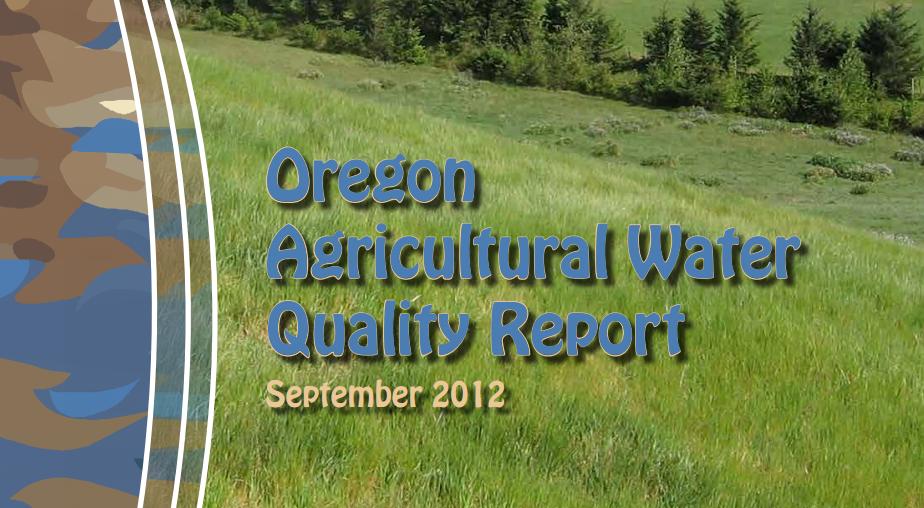September 26, 2012 — A lot has happened since the Oregon Legislature passed Senate Bill 1010 in 1993, giving birth to the Oregon Department of Agriculture’s Water Quality Management Program. A new report issued by ODA details the 19-year history of the program, its accomplishments, its strengths, and its current day challenges, setting the stage for a strategy aimed towards the future.
“Our program has been and will continue to be successful in addressing and, frankly, reducing agriculture’s negative impacts on water quality,” says ODA Director Katy Coba. “It has mobilized a great deal of effort with a lot of people in agriculture and many agencies putting in a lot of work already throughout the state. They should be commended for their commitment. Going forward and given the agency’s available resources, as well as the need to demonstrate effectiveness, the question is what should ODA’s Agricultural Water Quality Program look like?”
The 30-page report frames the issues that lead up to Coba’s question. The report is the agency’s first attempt at describing in full detail the program’s status and its effectiveness. It provides a history of the program, ODA’s relationship with soil and water conservation districts (SWCDs) in achieving water quality progress, ODA’s coordination with other agencies and organizations, stakeholder involvement, and compliance with water quality regulations. The report ends with a section on monitoring and a series of maps that provide a limited amount of data charting water quality trends.
The report was developed at the request of the Senate Environment and Natural Resources Committee and was first presented to the committee earlier this month.
“As we began to develop the report, we saw it as an opportunity to do a detailed internal review of our program,” says Ray Jaindl, director of ODA’s Natural Resources Program Area. “We solicited feedback from others outside the agency. That review has challenged us to look for ways to improve the program in the future.”
Jaindl is in a unique position to appreciate the new report. He was hired by ODA in 1993– the year the department was directed by the legislature to develop and administer a program that works with farmers and ranchers to improve agriculture’s contribution to water quality.
“I was hired to work on a pilot project in which state agencies worked together to implement a program designed to improve water quality and salmon habitat,” says Jaindl. “The project required working with landowners and providing them resources for on-the-ground projects. It also required the agency programs to be more integrated. It was good preparation for what was to be ODA’s new water quality management program.”
Under ODA’s program, plans and rules for 38 basins statewide have been adopted, which determine how agriculture is going to deal with water quality problems. The focus has been on getting the rules in place and working with landowners to complete on-the-ground projects. With help from SWCDs, watershed councils, the Oregon Watershed Enhancement Board– which provides funding for many projects– and technical assistance from the US Department of Agriculture’s Natural Resources Conservation Service, many landowners have completed projects. Some have done so on their own. The partnerships have allowed the program to be effective.
“ODA is just one piece of the ag water quality effort,” says Jaindl. “Are we in a perfect place right now? No. But compared to the program’s beginning in 1993, we are now integrating with other agencies’ programs in a complementary way to use the state’s resources effectively and not duplicate efforts.”
Agricultural water quality plans and rules address a wide range of conditions in basins such as erosion, siltation, animal waste management, and riparian area management. Plans are outcome based and provide flexibility so landowners can develop their own approaches to local water quality problems. The plans do not emphasize enforcement as the primary method for assuring success, although compliance is a component of the program. The new report reflects the regulatory aspect of the program.
“A key take home message from this report is that a regulatory program alone will not achieve the state’s water quality needs,” says Jaindl. “We don’t have sufficient resources to implement a regulatory program for all landowners. We need the outreach and education provided by the ag partnership to accomplish our goals.”
The State Board of Agriculture, which is helping to provide direction on improving an already effective ODA water quality program, weighed in this past week at its quarterly meeting in Medford.
“ODA has done a great job of balancing advocacy and enforcement,” says board chair Doug Krahmer.
But a challenge remains in telling the story.
“Our communication to the public about the program is one of the more important aspects that needs to improve,” says board member Tracey Liskey.
To that end, steps are being taken to quantify the impact of ODA’s program and all the on-the-ground efforts to improve conditions. ODA has received new resources from the legislature this biennium to implement additional monitoring sites around the state, in cooperation with the Oregon Department of Environmental Quality, in order to get a better idea of program effectiveness.
The report is a springboard to strategically position ODA’s water quality program to be the best it can be. With feedback from industry organizations and other interest groups, ODA staff will provide some options for the Board of Agriculture to review at its next meeting in November. No matter what changes are made, the issue of water quality is not going away and ODA’s program will remain a key player in the years to come.
Get the 2012 Oregon Agricultural Water Quality Report from our website or download it directly from ODA.
For more information, contact Ray Jaindl at (503) 986-4713.
For an audio version of this story, please go to https://oregon.gov/ODA/Pages/news/120926water_quality_audio.aspx
The source of this news item is the Oregon Department of Agriculture.


